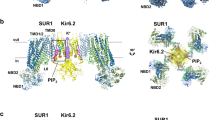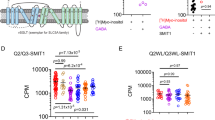Abstract
SULPHONYLUREAS are a class of drugs widely used to treat non-insulin-dependent diabetes mellitus. These drugs act by binding to a sulphonylurea receptor (SUR) in the pancreatic β-cell membrane which inhibits an ATP-sensitive potassium (K-ATP) channel and thereby stimulates insulin secretion. There has been much debate as to whether SUR and the K-ATP channel are the same or separate proteins, whether SUR confers ATP-sensithity on an ATP-insensitive pore-forming subunit, and whether sulphonylureas can also modulate other types of K-channel. We show here that SUR itself does not possess intrinsic channel activity but that it endows sulphonylurea sensitivity on several types of inwardly-rectifying It-channels. It does not necessarily confer ATP-sensitivity on these channels.
This is a preview of subscription content, access via your institution
Access options
Subscribe to this journal
Receive 51 print issues and online access
$199.00 per year
only $3.90 per issue
Buy this article
- Purchase on Springer Link
- Instant access to full article PDF
Prices may be subject to local taxes which are calculated during checkout
Similar content being viewed by others
References
Aguilar-Bryan, L et al. Science 268, 423–425 (1995).
Thomas, P. M. et al. Science 268, 425–429 (1995).
Ashcroft, S. J. H. & Ashcroft, F. M. Biochim biophys Acta 1175, 45–59 1992).
Zünckler, B. J., Lenzen, S., Männer, K., Panten, U. & Trube, G. Nanyn-Schmiedebergs Archs Pharmak. 337, 225–230 (1988).
Trube, G., Rorsman, P. & Ohno-Shosaku, T. Pflügers Arch. 407, 493–499 (1986).
Ashcroft, S. J. H. & & Ashcroft, F. M. Cell Sig. 2, 197–214 (1990).
Doupnik, C. A., Davidson, N. & Lester, H. A. Curr. Opin. Cell Biol. 5, 268–278 (1995).
Ho, K. et al. Nature 362, 31–39 (1993).
Inagaki, N. et al. J. biol. Chem. 270, 5691–5694 (1995).
Tsuchiya, T., Wang, W., Geibisch, G. & Welling, P. A. Proc. natn. Acad. Sci. U.S.A. 89, 6418–6422 (1992).
Higgins, C. F. Cell 82, 693–696 (1995).
Sheppard, D. N. & Welsh, M. J. J. gen. Physiol. 100, 573–593 (1992).
Inagaki, N. et al. Science 270, 1166–1170 (1995).
Sakura, H., Ämmälä, C., Smith, P. A., Gribble, F. M. & Ashcroft, F. M. FEBS Lett. 377, 338–344 (1995).
Author information
Authors and Affiliations
Rights and permissions
About this article
Cite this article
Ämmälä, C., Moorhouse, A., Gribble, F. et al. Promiscuous coupling between the sulphonylurea receptor and inwardly rectifying potassium channels. Nature 379, 545–548 (1996). https://doi.org/10.1038/379545a0
Received:
Accepted:
Issue Date:
DOI: https://doi.org/10.1038/379545a0
This article is cited by
-
Neuroprotective role of ATP-sensitive potassium channels in cerebral ischemia
Acta Pharmacologica Sinica (2013)
-
Sulfonylurea Receptor 1 in Central Nervous System Injury: A Focused Review
Journal of Cerebral Blood Flow & Metabolism (2012)
-
Oral administration of the KATP channel opener diazoxide ameliorates disease progression in a murine model of multiple sclerosis
Journal of Neuroinflammation (2011)
-
Identification of a Novel Bacterial K+ Channel
The Journal of Membrane Biology (2011)
-
Phosphoinositide-mediated gating of inwardly rectifying K+ channels
Pflügers Archiv - European Journal of Physiology (2007)
Comments
By submitting a comment you agree to abide by our Terms and Community Guidelines. If you find something abusive or that does not comply with our terms or guidelines please flag it as inappropriate.



